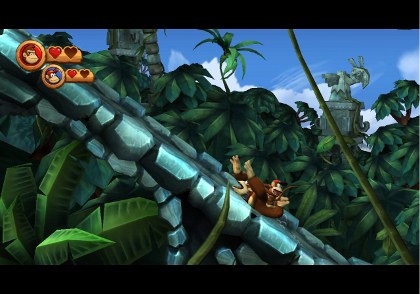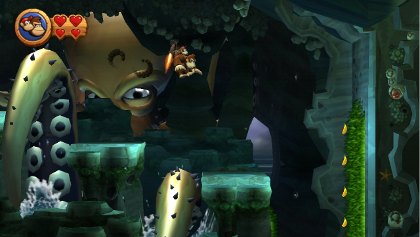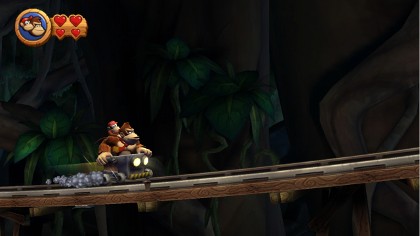
The fast pace and smooth flow of the levels has more in common with Sonic than the Mario series that Donkey Kong senior spawned.
Donkey Kong’s leap into the polygonal era has brought more than just some fancy animations and a clean new look – it replaces the original games’ copious layers of parallax with bona fide interactive background layers that you can bound between using barrels. This makes for some thrilling chase sequence set-pieces between layers and adds a depth of field that most 2.5D games miss. The sparingly used Limbo-esque silhouette graphic effect is inventive and visually arresting, and in truth, could probably use a little more exposure.
In a similar fashion to Super Mario Galaxy, set pieces are DKCR’s forte. Many levels begin with an idea that’s exploited fully by its conclusion, only to be cast aside as soon as the next level begins. One minute you’re evading the flailing tentacles of a giant octopus chasing you through the level, the next you’re hiding behind craggy rocks to avoid huge tidal waves crashing from the background. The variety is consistent and you never know what to expect.

Background elements with make it their business to creep into your play area in many of the game's set-piece levels.
While DKCR undoubtedly outdoes its predecessors in terms of imaginative level design, there are a few omissions that Retro would’ve been wise to include. DKC’s animal helpers are largely absent; only the one–rhino wrecking crew Rambi makes the cut in some spectacularly destructive levels. DKC’s serenely beautiful underwater levels are nowhere to be found either, though they at least managed to tag the aquatic ambience track onto another water-themed level.
Multiplayer holds together a little better than New Super Mario Bros’ chaotic fumbles, not least because there are only two of you and you don’t have to tussle for position, but also because of the division of labour in choosing Donkey or Diddy. Donkey, best in the hands of an experienced player, keeps his ground clap essential for uncovering secret areas, while Diddy gets his pop gun to stun enemies from distance and that vital hover jump is more suited to newcomers.

The mine cart chase is a long-lost trope of the 16-bit era. DKCR reminds you what the fuss was all about.
Nintendo’s almost controversial Super Guide returns for a third time, and while Miyamoto’s warnings regarding NSMB’s difficulty level were greatly exaggerated, tales of DKCR’s unbreakable nature are most certainly not. As early as world two, the difficulty level ratchets up and by the later hidden stages you will be forced into some devilishly brutal situations. Don’t be surprised if frustration exceeds embarrassment and you are forced to call upon the silverback Super Kong push through to the next stage. Patience and observation will always prevail and the challenge is always fair, but it pushes players further than any mainstream Nintendo release in recent history, and is all the better for it.
DKCR is more than a bold and confident return for Nintendo’s oldest character – it’s an advert for the skills that Nintendo can call upon from Retro Studios. It proves that the Metroid Prime series wasn’t a fluke and that their understanding of what makes an exceptional IP spans character, tone and even genre. In a generation where Nintendo seem ever-more preoccupied with hardware innovation and its expanded audience, Retro’s dependable high-quality output bodes well for the future. Now what else can Nintendo give them?






 Satoru Iwata Video Interview - the late Nintendo president spoke with Kikizo in 2004 as 'Nintendo Revolution' loomed.
Satoru Iwata Video Interview - the late Nintendo president spoke with Kikizo in 2004 as 'Nintendo Revolution' loomed. Kaz Hirai Video Interview - the first of Kikizo's interviews with the man who went on to become global head of Sony.
Kaz Hirai Video Interview - the first of Kikizo's interviews with the man who went on to become global head of Sony. Ed Fries Video Interview - one of Xbox's founders discusses an epic journey from Excel to Xbox.
Ed Fries Video Interview - one of Xbox's founders discusses an epic journey from Excel to Xbox. Yu Suzuki, the Kikizo Interview - we spend time with one of gaming's most revered creators.
Yu Suzuki, the Kikizo Interview - we spend time with one of gaming's most revered creators. Tetris - The Making of an Icon: Alexey Pajitnov and Henk Rogers reveal the fascinating story behind Tetris
Tetris - The Making of an Icon: Alexey Pajitnov and Henk Rogers reveal the fascinating story behind Tetris Rare founders, Chris and Tim Stamper - their only interview? Genuinely 'rare' sit down with founders of the legendary studio.
Rare founders, Chris and Tim Stamper - their only interview? Genuinely 'rare' sit down with founders of the legendary studio. The History of First-Person Shooters - a retrospective, from Maze War to Modern Warfare
The History of First-Person Shooters - a retrospective, from Maze War to Modern Warfare